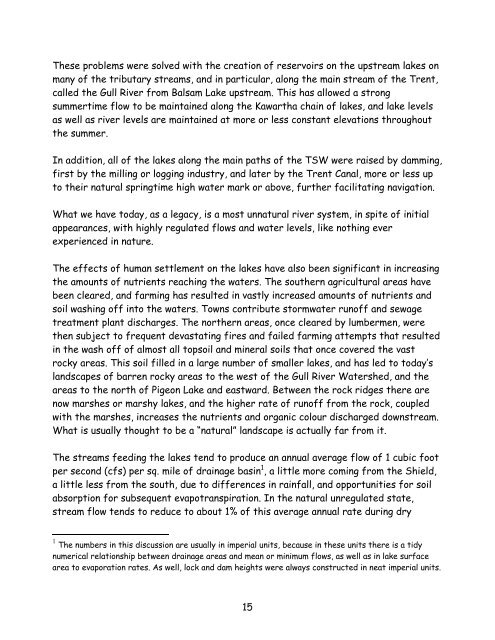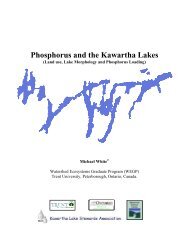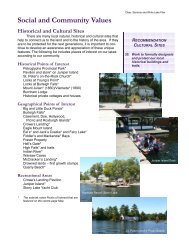Lake Water Quality 2006 Report - Lakefield Herald
Lake Water Quality 2006 Report - Lakefield Herald
Lake Water Quality 2006 Report - Lakefield Herald
You also want an ePaper? Increase the reach of your titles
YUMPU automatically turns print PDFs into web optimized ePapers that Google loves.
These problems were solved with the creation of reservoirs on the upstream lakes onmany of the tributary streams, and in particular, along the main stream of the Trent,called the Gull River from Balsam <strong>Lake</strong> upstream. This has allowed a strongsummertime flow to be maintained along the Kawartha chain of lakes, and lake levelsas well as river levels are maintained at more or less constant elevations throughoutthe summer.In addition, all of the lakes along the main paths of the TSW were raised by damming,first by the milling or logging industry, and later by the Trent Canal, more or less upto their natural springtime high water mark or above, further facilitating navigation.What we have today, as a legacy, is a most unnatural river system, in spite of initialappearances, with highly regulated flows and water levels, like nothing everexperienced in nature.The effects of human settlement on the lakes have also been significant in increasingthe amounts of nutrients reaching the waters. The southern agricultural areas havebeen cleared, and farming has resulted in vastly increased amounts of nutrients andsoil washing off into the waters. Towns contribute stormwater runoff and sewagetreatment plant discharges. The northern areas, once cleared by lumbermen, werethen subject to frequent devastating fires and failed farming attempts that resultedin the wash off of almost all topsoil and mineral soils that once covered the vastrocky areas. This soil filled in a large number of smaller lakes, and has led to today’slandscapes of barren rocky areas to the west of the Gull River <strong>Water</strong>shed, and theareas to the north of Pigeon <strong>Lake</strong> and eastward. Between the rock ridges there arenow marshes or marshy lakes, and the higher rate of runoff from the rock, coupledwith the marshes, increases the nutrients and organic colour discharged downstream.What is usually thought to be a “natural” landscape is actually far from it.The streams feeding the lakes tend to produce an annual average flow of 1 cubic footper second (cfs) per sq. mile of drainage basin 1 , a little more coming from the Shield,a little less from the south, due to differences in rainfall, and opportunities for soilabsorption for subsequent evapotranspiration. In the natural unregulated state,stream flow tends to reduce to about 1% of this average annual rate during dry1 The numbers in this discussion are usually in imperial units, because in these units there is a tidynumerical relationship between drainage areas and mean or minimum flows, as well as in lake surfacearea to evaporation rates. As well, lock and dam heights were always constructed in neat imperial units.15





